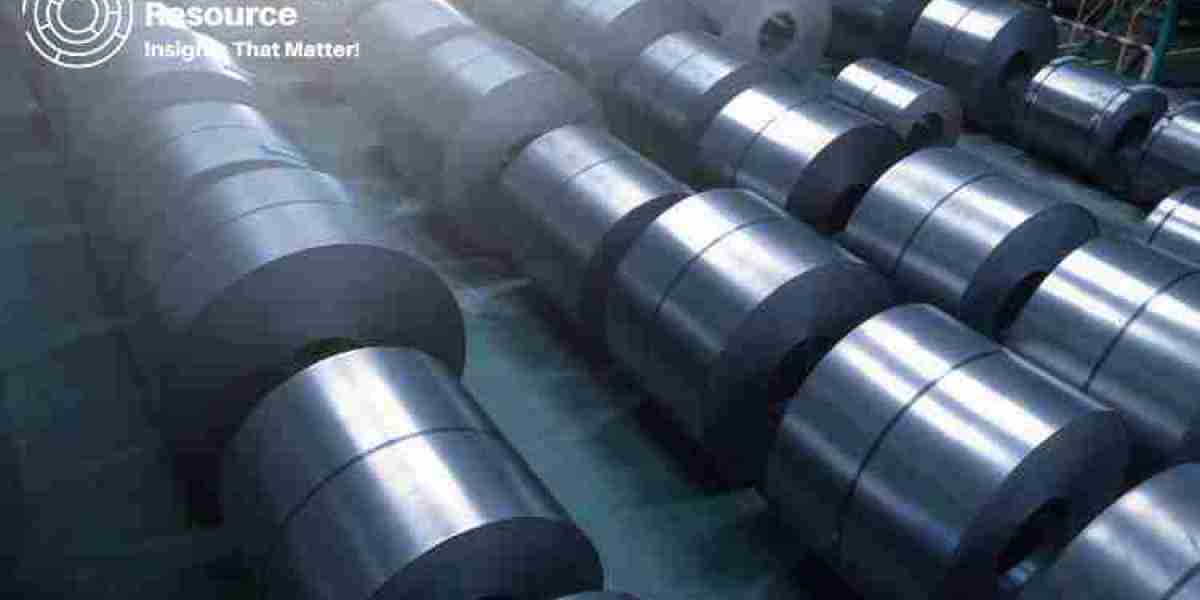Cold rolled coil (CRC) is a type of steel that has been rolled at room temperature, below its recrystallization temperature, to achieve desired thickness and surface finish. CRC is known for its superior surface quality, dimensional accuracy, and mechanical properties, making it a preferred choice in various industries including automotive, construction, and appliance manufacturing. This blog provides an in-depth analysis of the cold rolled coil production process, covering the manufacturing process, raw material costs, and recent developments in the industry.
Manufacturing Report and Process
The cold rolling process is an integral part of steel manufacturing, where hot rolled coils are processed further to enhance their properties. The entire process can be broken down into several key steps:
Pickling: The hot rolled coils, which typically have a layer of oxide on the surface, are passed through an acid bath to remove this oxide layer. This step, known as pickling, ensures a clean surface for further processing.
Cold Rolling: After pickling, the coils are fed into a cold rolling mill. This mill consists of several rollers that apply high pressure to the steel, reducing its thickness and imparting a uniform, smooth surface finish. The rolling is done at room temperature, which enhances the strength and hardness of the steel.
Annealing: The cold rolled steel is then annealed to relieve the internal stresses induced during the rolling process. Annealing involves heating the steel to a specific temperature and then cooling it slowly. This process not only improves ductility but also enhances the overall mechanical properties of the steel.
Skin-Passing: The final step in the cold rolling process is skin-passing, where the annealed steel is passed through a set of rollers to achieve the desired surface texture and slight reduction in thickness. This step also improves the flatness of the steel.
Cutting and Finishing: The cold rolled coils are then cut to the required dimensions and undergo various finishing processes, such as trimming, slitting, and coating, depending on the end-use requirements.
Request For Sample: https://www.procurementresource.com/production-cost-report-store/cold-rolled-coil/request-sample
The cold rolled coils produced through this process are characterized by high dimensional accuracy, excellent surface finish, and enhanced mechanical properties, making them suitable for a wide range of applications.
Raw Material Costs
The production of cold rolled coil is heavily dependent on the cost and availability of raw materials, primarily hot rolled coil (HRC). The price of HRC is influenced by various factors, including:
Iron Ore Prices: Iron ore is the primary raw material for steel production, and fluctuations in its prices directly impact the cost of HRC and consequently CRC. Global supply and demand dynamics, mining output, and geopolitical factors play a significant role in determining iron ore prices.
Energy Costs: The cold rolling process is energy-intensive, requiring substantial amounts of electricity and fuel. Variations in energy costs can significantly affect the overall production cost of CRC.
Labor Costs: The cost of labor is another crucial factor in the production of cold rolled coil. Skilled labor is required for operating and maintaining the rolling mills, and any changes in labor costs can influence the production expenses.
Transportation and Logistics: The cost of transporting raw materials to the production facility and finished products to the market also impacts the overall production cost. Factors such as fuel prices, transportation infrastructure, and distance from raw material sources to production facilities play a crucial role in this regard.
Market Demand: The demand for cold rolled coil in various industries affects its price. High demand can drive up prices, while low demand can lead to price reductions. Economic conditions, industrial growth, and construction activities are some of the factors that influence market demand.
Understanding these cost factors is essential for manufacturers to optimize their production processes and remain competitive in the market.
Latest News
The cold rolled coil industry is continuously evolving, with various technological advancements and market dynamics shaping its future. Some of the latest developments in the industry include:
Technological Advancements: Innovations in rolling mill technology, such as the introduction of advanced automation and control systems, are enhancing the efficiency and precision of the cold rolling process. These advancements are leading to higher production rates, improved product quality, and reduced operational costs.
Sustainability Initiatives: With increasing emphasis on environmental sustainability, manufacturers are adopting eco-friendly practices in their production processes. The use of energy-efficient equipment, recycling of waste materials, and reduction of carbon emissions are some of the measures being implemented to minimize the environmental impact of cold rolled coil production.
Market Expansion: The demand for cold rolled coil is witnessing significant growth in emerging markets, driven by rapid industrialization and urbanization. Countries in Asia-Pacific, particularly China and India, are investing heavily in infrastructure development and manufacturing, leading to increased demand for CRC.
Trade Policies: Changes in trade policies and tariffs are influencing the global cold rolled coil market. For instance, the imposition of tariffs on steel imports by major economies like the United States has affected the supply chain and pricing dynamics of CRC. Manufacturers need to stay updated with these policies to navigate the complexities of international trade.
Supply Chain Disruptions: The COVID-19 pandemic has highlighted the vulnerabilities in global supply chains, impacting the availability of raw materials and the transportation of finished products. Manufacturers are now focusing on building resilient supply chains and exploring local sourcing options to mitigate such risks in the future.
Industry Collaborations: Collaborations and partnerships between steel manufacturers, technology providers, and research institutions are fostering innovation and driving the development of new products and processes in the cold rolled coil industry. These collaborations are aimed at enhancing product quality, reducing costs, and meeting the evolving needs of end-users.
Conclusion
The cold rolled coil production process is a complex and critical aspect of the steel manufacturing industry. Understanding the intricacies of this process, along with the factors influencing raw material costs and the latest industry trends, is essential for stakeholders to make informed decisions and stay competitive. As the industry continues to evolve with technological advancements and sustainability initiatives, manufacturers must adapt to the changing landscape to capitalize on emerging opportunities and overcome challenges.













